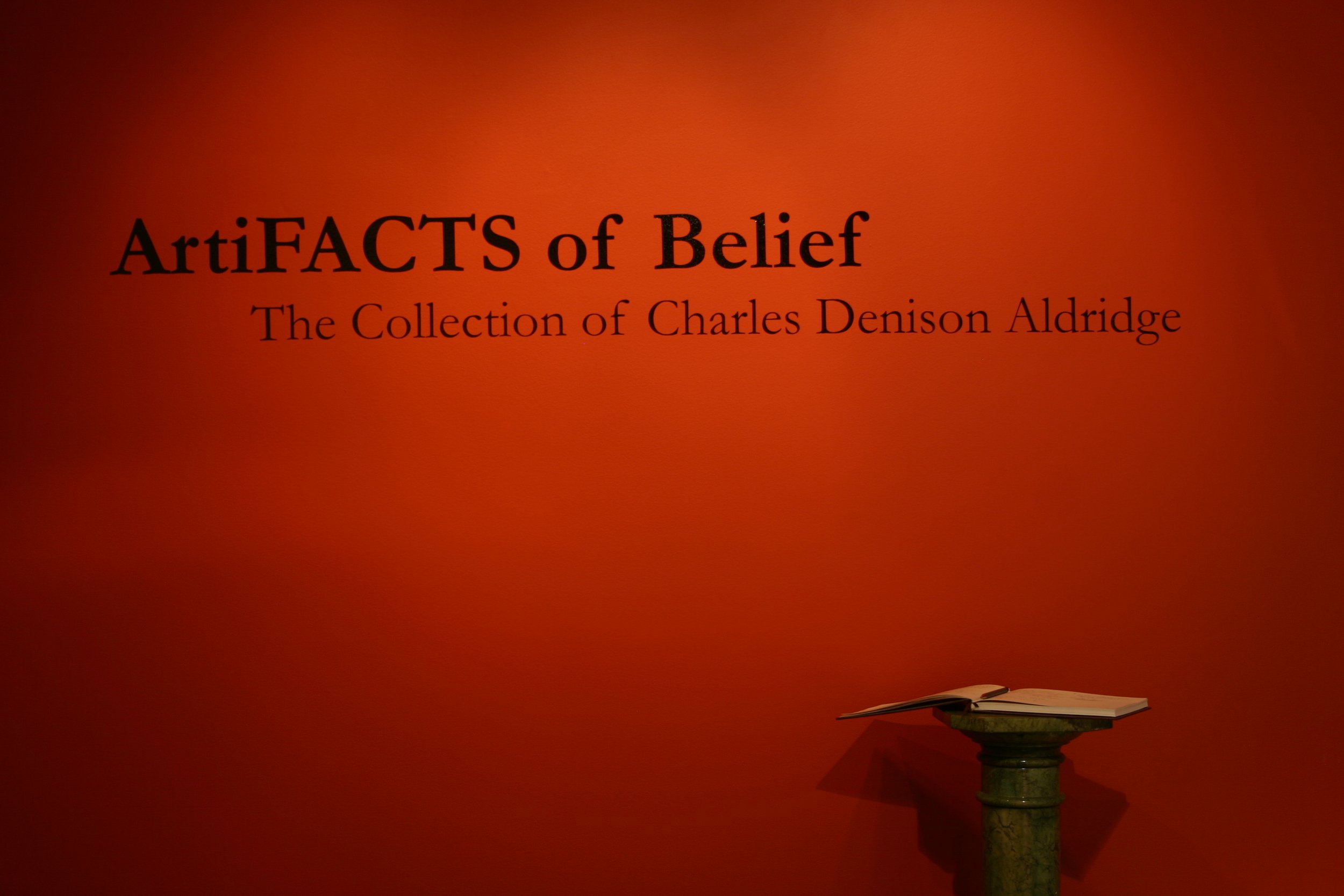ArtiFACTS of Belief: The collection of Charles Edison Aldridge
February 19 - April 3, 2010
University of Toronto Art Centre Art Lounge, University of Toronto Art Centre
Yael Filipovic, Erika Wilson, Carrie Mckay
"The purpose of ArtiFACTS of Belief is to challenge viewers to question the nature of belief and their trust in the museum. The didactic approach and familiar aesthetic of traditional natural history displays has created a convention in which the museum’s authority is rarely questioned. ArtiFACTS investigates these established traditions and remarks on how they influence the viewer’s perception of an exhibition’s content, by presenting the viewer with fantastical artifacts in a familiar museological context.
Although not intended for children, we were both interested to see how this exhibition would be received within an academic setting (especially with others interested in museology) but also with the general public. This led us to pursuing UTAC as our preferred location, as it nicely met both of these publics. The location at UTAC also allowed us to consider the display techniques of this institution, especially its Malcove collection.
We did not have any sponsors outside the class funding. We had to fundraise in order to create a collection of an affluent Victorian industrialist, which looked believable, including three unbelievable life-size skeletons. We organized 5 roaming bake sales on campus before the exhibition and a silent auction at the end of the exhibition, selling the artifacts we had constructed and collected ourselves (i.e. not loaned items).
This project started in the summer of 2010 prior to the start of class. By Sept. 2010 we had finalized our proposal, location and theoretical framework. From October to January our time was focused on gathering items to be part of the 'collection' and constructing our three life size skeletons of the Easter Bunny, Santa Claus and the Tooth Fairy. This was largely the most time consuming aspect and was done in one of our team mate's apartment (sanding, altering, painting, assembling, etc.)
ArtiFACTS of Belief introduces the story of a Charles Denison Aldridge, a fictional Victorian collector, whose collection is comprised of actual natural history specimens, as well as the fabricated skeletons of Santa Claus, the Easter Bunny and the Tooth Fairy. These unbelievable specimens are presented as factual; their authenticity validated by rusted and traditional display methodology common to natural history museums. The visitor must reconcile their disbelief in the existence of these characters from childhood with the tangible material evidence of their existence, which is presented in a familiar, factual manner. As the audience grapples with their belief in familiar museum display and their expired belief in mythical characters, they question the nature of belief. In the text panels we describe the museological issues we were bringing forth with our artifacts and display aesthetic. These texts provided context and stimulated engagement. Our collecting process was threefold; actual natural history specimens, found and created artifacts supporting the characters, and borrowed period pieces for Aldridge’s personal belongings. Several general calls for objects resulted in donations and loans from friends and organizations. Each item was considered a personal loan, as an institutional loan would have meant shouldering UTAC with the responsibility for their safekeeping. Fortunately the organizations we dealt with were comfortable with this arrangement.
We designed our own exhibition invitation cards and distributed them to key locations on campus, other galleries, and friends and family to advertise the opening. The exhibition also received two reviews: one on the UTAC blog and a curatorial review by a classmate. We did a curatorial talk with the Curatorial Practice class to open up conversations about the common issues addressed in the exhibition and the course. The curatorial talk felt awkward to us because it assumed the authoritative voice that we positioned as problematic within the exhibition. Due to this thematic conflict, we attempted to create dialogue and discussion about the exhibition through our programming.
The feedback was the most interesting outcome. Many people congratulated us; classmates told us the exhibition was well-executed and raised interesting issues. Of those who were unfamiliar with the museological issues we were addressing, some determined the message to be ‘don’t believe everything you see’, and ‘question authenticity’. Yet others were confused as to whether Charles Denison Aldridge actually existed and if the collection was authentic. A few thought it was a “funny show”, without grasping the larger inferences. The feedback made us re-evaluate whether or not the show was explicit enough. We even reconsidered the location of the conclusion panel, theorizing that making it more prominent would encourage people to read the explicit ‘reveal’. Ultimately, we decided to keep the panel in its original location, because we believed that most visitors would arrive at the interpretation we hoped for, from the rest of the exhibition.
We would like to acknowledge our exhibition class and the class of 2010, Matthew Brower, Cheryl Meszaros and Jennifer Carter, Toronto District School Board, Hope for Wildlife Animal Rescue, all our family, friends and colleagues who donated or lent us items to be part of the collection, and so many more people who contributed to this project on so many different levels." ArtiFACTS of Belief: The Collection of Charles Denison Aldridge is an exhibition that explores how certain types of displays influence the museum visitor by affecting their perception of the authenticity of the content on display. Through the traditions of natural history museum displays, ArtiFACTS of Belief presents ideas of how interpretation and belief is constructed within museum environments, and confronts viewers with questions of authority and authenticity within museum displays.
History exhibition
Tags: artifacts, authenticity, display, fiction, institutional critique, interpretation, museology, natural history, perception


